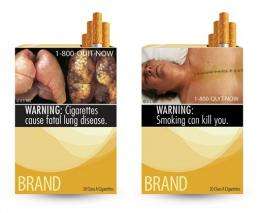Court: State can't scare smokers with gross images (Update)

(AP) — New York City cannot try to scare smokers by requiring grotesque images of diseased lungs and decaying teeth at stores that sell cigarettes because the federal government gets to decide how to warn people about the dangers of smoking tobacco, an appeals court ruled Tuesday.
The 2nd U.S. Circuit Court of Appeals in Manhattan rejected a 2009 city Board of Health resolution requiring tobacco retailers to display signs bearing graphic images showing the adverse health effects of smoking.
Upholding a ruling by Judge Jed S. Rakoff in Manhattan, the appeals court said the resolution is pre-empted by the Federal Cigarette Labeling and Advertising Act, enacted by Congress in 1965. It said letting local authorities require the posting of warnings near cigarette displays that are meant to supplement those already on boxes of cigarettes risks creating diverse, non-uniform and confusing regulations.
Richmond, Virginia-based cigarette manufacturer Philip Morris USA, which had sued to block the poster requirement, said it was pleased with the court's ruling.
"This suit has always been about who has the authority to regulate the content of cigarette warnings," said attorney Murray Garnick, who was quoted in a statement speaking on behalf of Philip Morris USA. "That is a power reserved to the federal government without interference or additional efforts by state and local authorities."
The city's health department said the ruling was likely to reduce the number of smokers who quit.
"The city's warning signs depicted the grisly toll of smoking and provided helpful information about how to quit at a place where smokers were most likely to see it," the health department said in a statement. "Despite huge strides in combating smoking in New York City, tobacco remains the city's number one killer and we remain committed to providing smokers with life-saving information and resources to overcome their addiction."
The health department had produced three signs for retailers. One depicted an X-ray image of a cancerous lung over the warning: "Smoking Causes Lung Cancer." The second showed a decaying, extracted tooth over the warning: "Smoking Causes Tooth Decay." The third showed a brain with damaged tissue resulting from a stroke and was accompanied by the words: "Smoking Causes Stroke."
The resolution was challenged by two cigarette retailers, two trade associations and three of the nation's largest cigarette manufacturers, including Philip Morris. The city also has banned smoking in indoor workspaces, increased cigarette taxes, initiated educational campaigns and promoted smoking cessation programs.
When Rakoff ruled in December 2010, he wrote: "Even merchants of morbidity are entitled to the full protection of the law."
He said the posters offered by the city contained "graphic, even gruesome images," though he noted that one-third of smokers die of tobacco-related diseases and more people in New York die from smoking annually than from AIDS, homicide and suicide combined.
The appeals court made clear in its ruling that it did not believe every state or local regulation affecting promotion of cigarettes interferes with federal law. It said only those requirements or prohibitions directly affecting the content of the manufacturers' promotional message to consumers can be blocked.
The 2nd Circuit said the city can launch its own anti-smoking campaigns but can't require a manufacturer or retailer to display supplemental content at the point of purchase.
Copyright 2012 The Associated Press. All rights reserved. This material may not be published, broadcast, rewritten or redistributed.
















